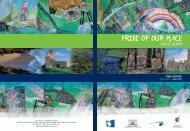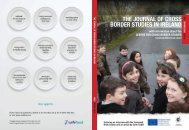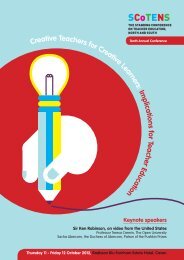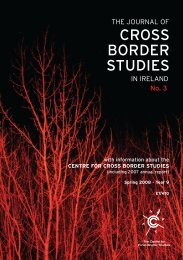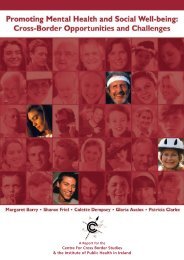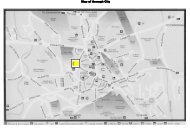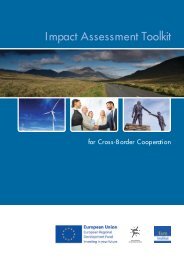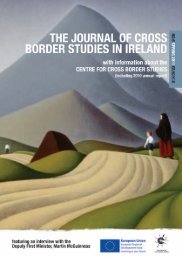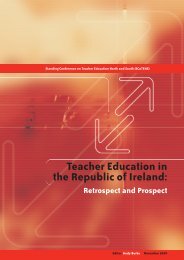improving government service delivery to minority ethnic ... - NCCRI
improving government service delivery to minority ethnic ... - NCCRI
improving government service delivery to minority ethnic ... - NCCRI
You also want an ePaper? Increase the reach of your titles
YUMPU automatically turns print PDFs into web optimized ePapers that Google loves.
Although the power <strong>to</strong> legislate on equal opportunities is reserved <strong>to</strong> the UK Government, the Scottish<br />
Parliament has the power <strong>to</strong> encourage equal opportunities, as well as the power <strong>to</strong> impose duties on Scottish<br />
public bodies and cross-border public authorities in relation <strong>to</strong> their Scottish functions.<br />
In 1999 the Scottish Parliament established an Equal Opportunities Committee as one of its eight manda<strong>to</strong>ry<br />
committees. The committee has responsibility for considering and reporting on equal opportunities issues and<br />
moni<strong>to</strong>ring equal opportunities in Parliament. The Parliament’s standing orders also require that all proposed<br />
legislation presented <strong>to</strong> the Executive is accompanied by a statement of impact on equal opportunities. The<br />
Parliament has also used its powers <strong>to</strong> place more specific duties on certain bodies in respect of aspects of<br />
education, housing, care and social <strong>service</strong>s.<br />
139_Public Health<br />
News (2005),<br />
Why is Scotland’s<br />
population shrinking<br />
and ageing?- a new<br />
research initiative.<br />
(18 April 2005)<br />
Currently there is no Race Equality Strategy for Scotland. There is a generic Equality Strategy, first published in<br />
2000. A Review of Race Equality in Scotland, published in November 2005, introduced a number of measures<br />
aimed at reducing discrimination and challenging racism. The Review also announced that there would be a<br />
Race Equality Strategy and Action Plan announced in the autumn of 2006.<br />
Demographics<br />
Scotland has a long tradition of immigration with the first recorded Africans in Scotland in the Court of King<br />
James IV in 1505. However, more recently, from the mid twentieth century onwards we have seen increased<br />
migration <strong>to</strong> Scotland. People from India, Pakistan, Bangladesh, the Caribbean and Nigeria were recruited <strong>to</strong><br />
come <strong>to</strong> Britain <strong>to</strong> fill labour shortages and many settled in Scotland. The largest community is the community<br />
of Pakistani origin and the largest Pakistani Community is well established in Glasgow. The 2001 census<br />
showed that 47% of the people of Pakistani origin in Scotland were born in Scotland. There is also an<br />
established Chinese community in Scotland. The pattern of self-employment within the Chinese community<br />
(mainly in the restaurant business) means that as a community they are scattered throughout Scotland, and in<br />
the rural areas the Chinese community is the largest visible <strong>ethnic</strong> <strong>minority</strong> group. A Chinese community has<br />
been established in Glasgow since the 1960s.<br />
In Scotland the Scottish Executive have produced an analysis of <strong>ethnic</strong>ity in the 2001 Census which<br />
consolidates all the data in relation <strong>to</strong> <strong>ethnic</strong>ity in Scotland and which highlights key socio-economic data<br />
related <strong>to</strong> housing, the labour market, health care and education. 139 This is an important publication in the<br />
context of this study and provides policy makers and <strong>service</strong> providers a basis from which <strong>to</strong> benchmark the<br />
socio-economic progress of <strong>minority</strong> <strong>ethnic</strong> groups in Scotland in Intercensal periods. As a consequence, in<br />
this study there is significantly more detailed data available for Scotland than for Ireland and Northern Ireland.<br />
Based on data from the 2001 Census, the size of the <strong>minority</strong> <strong>ethnic</strong> population was just over 100,000,<br />
which accounts for 2% of the <strong>to</strong>tal population of Scotland. (5.062 million in 2001). Pakistanis are the largest<br />
<strong>minority</strong> <strong>ethnic</strong> group, followed by Chinese, Indians and those of mixed <strong>ethnic</strong> backgrounds. Over 70% of the<br />
<strong>to</strong>tal <strong>minority</strong> <strong>ethnic</strong> population were Asian: Indian, Pakistani, Bangladeshi, Chinese or other South Asian and<br />
over 12% of the population describe their <strong>ethnic</strong>ity as ‘Mixed’. The size of the <strong>minority</strong> <strong>ethnic</strong> population has<br />
increased since the 1991 Census. Whilst the <strong>to</strong>tal population increase between 1991 and 2001 was 1.3% the<br />
<strong>minority</strong> <strong>ethnic</strong> population increased by 62.3%.



